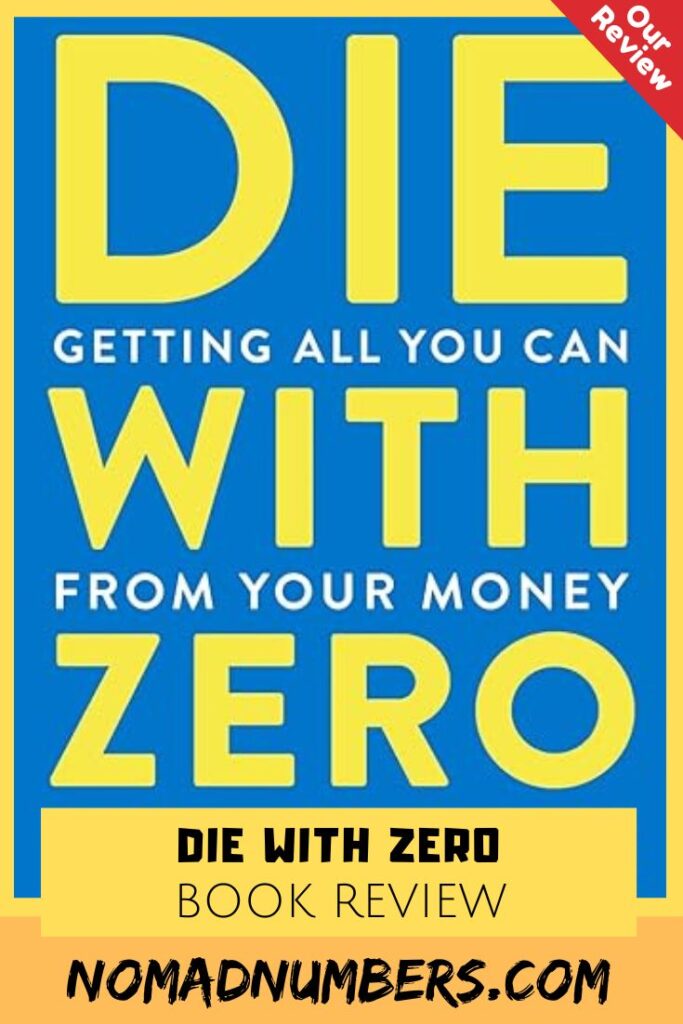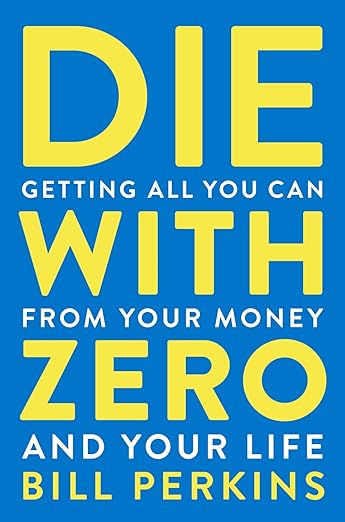Die with Zero by Bill Perkins is one of the top few books that recently has had a profound effect on how we approach our lives (which we added to our life changing book recommendations). This book offers a different perspective on personal finance and life optimization that really made us rethink our retirement planning and approach to spending. In this book review, we will break down the key ideas of the book, provide some practical advice as well as share our personal takeaways.
Like many others in the financial independence community, we have been ingrained to save and invest as much as possible to maximize our return. From our cost to travel the world reports we are currently spending between $30,000 and $40,000 per year to support our nomadic lifestyle which is actually well below the return of our portoflio. The concepts introduced in this book has adjusted our mindset on how we make decisions to spend. Let’s get into the Die with Zero book review!
Summary of Key Concepts from Die With Zero
Here are some of the key lessons and concepts from Die with Zero:
Net Fulfillment
This concept measures the balance between the joy and satisfaction derived from experiences and the associated costs, both financial and non-financial. The idea is to ensure that you derive the most happiness and fulfillment from their resources over their lifetime.
Maximize Life Experiences
The ultimate goal should be to maximize life experiences rather than simply accumulating wealth. He suggests that money should be spent strategically to create memorable and fulfilling experiences, particularly when one is young and healthy enough to enjoy them fully.
Experiences bring more lasting happiness and satisfaction than material possessions. So we should prioritize spending on activities that create memories and foster connections with loved ones.
Die with Zero
Perkins advocates for the idea of “dying with zero,” which means intentionally planning to empty your financial resources by the end of your life. This concept emphasizes the importance of enjoying your wealth during your lifetime rather than saving it for an uncertain future or leaving it unused. The book says that your net worth should peak in your 50s and not when you get into your late 60s.
Health and Wealth Intersection
The book underscores the importance of aligning spending with one’s health trajectory (something we covered in our review of the book Outlive by Peter Attia). Certain experiences require a level of physical fitness and energy that diminishes with age so it is important to either focus on increasing your healthspan or enjoying more adventurous and physically demanding activities earlier in life.
Investment in Relationships
The author also stresses the value of investing time and resources into relationships. Shared experiences with friends and family are some of the most fulfilling ways to spend money, contributing significantly to one’s overall happiness.
Planning and Calculated Risks
While advocating for spending, the book does not ignore the importance of planning. Perkins advises readers to take calculated risks with their finances, ensuring they have a safety net (ie. Emergency fund) but also encouraging them to avoid excessive caution that can lead to missed opportunities (ie. planning for the worse case scenario).
Inheritance and Charitable Giving
Something that caught our attention was the author’s approach to charitable giving and inheritance. He suggests giving away money while still alive, allowing you to see the impact of your contributions and experience the joy of giving firsthand. For example, he recommends giving to your children in their early 20s to help them bootstrap their lives, rather than waiting until after you’ve passed away when the money might have a lesser impact on their lives in their 60s.
To summarize, the Key Concepts of the Die With Zero book are
– prioritizing life experiences over accumulating wealth.
– balancing the joy from experiences with their associated costs
– spending money to create meaningful and fulfilling memories
– enjoy your wealth during our lifetime rather than saving it for later
– aligning spending with one’s health
– investing in relationships
– giving inheritance or charitable contributions while still alive to witness the positive impact firsthand
Practical Advice from Die With Zero
There’s a lot of practical advice you can take from the concepts of Die with Zero. Here are some of the ways you can apply some of the advice to reframe your retirement planning and approach to life in general:
Time Buckets
This concept involves dividing one’s life into different stages (usually a decade long) and planning specific experiences for each period (20s, 30s, 40s, 50s…). This helps ensure that you make the most of each phase of your life and add in the experience that will match your physical health throughout your life.
For example, if one of your goals is to maximize time spent with your kids before they are adults, you only have a window of about 10 years when they will be young enough and want to hang out with their parents! If your travel goals include doing a cruise to Antarctica and climbing Mount Killamanjaro, the cruise you can do well into your golden years but it would be an easier experience to climb a high elevation mountain when you are younger.
Track and Measure Experiences
Perkins recommends keeping a “memory dividend” log to track the experiences that have brought joy and fulfillment. This helps in appreciating past experiences and planning future ones. Basically the sooner the memory is created, the more opportunity you will have to reflect on it, share it and enjoy them over time.
Avoid Regret
A recurring theme is the avoidance of future regret by living more fully in the present. Perkins urges us to consider what we might regret not doing in our later years and to take steps to prevent those regrets now. One common cause of regret is not having enough courage to try something new or being afraid of what others might think. From a financial perspective, it could be the fear of spending money but it would be a huge shame to miss out on an experience to save some extra money (assuming you have the extra money).
To summarize, the Practical Advices from Die With Zero are:
– Dividing life into stages (e.g., 20s, 30s, 40s) and planning experiences that align with each period’s physical health and priorities.
– Maintaining a “memory dividend” log to track and appreciate joyful experiences, helping plan future ones and enjoy memories over time.
– Living fully in the present to prevent future regrets. Taking risks, trying new things, not letting fear—whether of spending money or others’ opinions—holding you back from meaningful experiences.
Perspectives on Money and Spending in Retirement
Here are some perspectives about money and spending in retirement highlighted by Die with Zero that could help you more easily accept the concepts from dying with zero.
- People will spend less money once they reach regular retirement age (65+) because they can experience less than were they were younger.
- The earlier you retire, the more likely you will still ending up using your time to still earn some money.
- Money is an abstract. It is a tool to reach your own fulfillment. Having money without goals in your life is waste of energy.
Personal Takeaways In Our Lives
The ideas and advice from Die With Zero is life changing! Just as The Simple Path to Wealth was life changing to our financial journey, this book is life changing to our living journey.
- We no longer fear running out of money in retirement or dying with zero. This book has reframed dying with zero as an admirable goal to plan towards and not something to fear.
- We no longer optimize for maximum savings but for maximum fulfillment. For example, we often booked the best value accommodation(within our standards) but now it doesn’t have to be the best value, as long as we like it best.
- We will take more ‘vacation’ trips. It’s sometimes hard to differentiate vacation from lifestyle when you are nomadic but we plan on taking more vacation style trips where we treat ourselves to more special experiences.
- We are planning our time buckets. There are a lot of experiences we want to have in life but there are many that should be done earlier rather than later. Spending quality time with our parents is a big one to enjoy now.
- Have more experiences with loved ones earlier on. We’ve been so thoughtful about building financial dividends and now we are focused on ‘memory dividends’.
- Have no regrets on our decision to pursue this nomadic lifestyle. When you are doing something against the norm, it’s common to question your decisions. With this new mindset to maximize experiences and fulfillment, we will no longer second guess ourselves.
Final Thoughts on Book Review of Die With Zero
Die with Zero is a thought-provoking book that challenges us to rethink our approach to money, life, and happiness. Bill Perkins provides a great argument for living a richer, more fulfilling life by focusing on experiences, relationships, and intentional spending. His ideas offer a fresh perspective on making the most of the finite time we have. We will certainly take the ideas and advice into practice in our lives and although our lives might not be richer in net worth, they will be richer in experiences!
If you’re looking for a book that will inspire you to reassess your financial priorities and embrace a more adventurous and experience-rich life, Die with Zero is an excellent read. If you read the book, please share if you agree with this book review and your biggest learning in the comments section below!





0 Comments